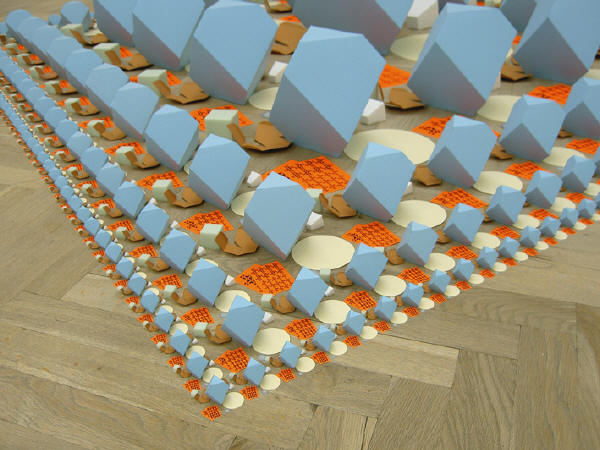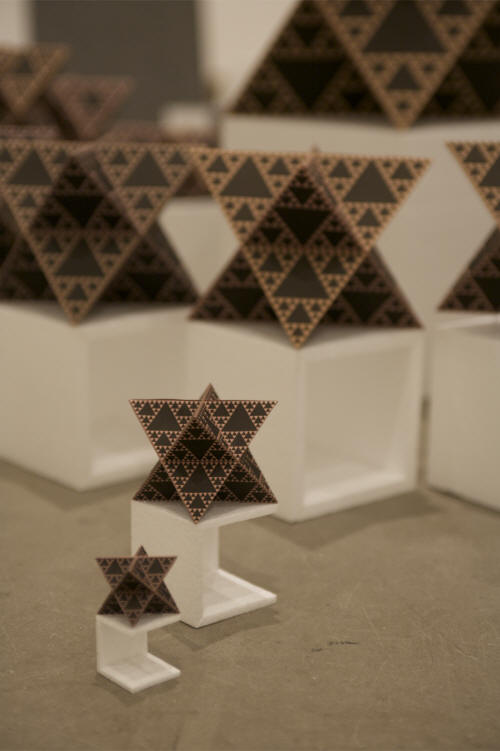|
|
| home | features | exhibitions | interviews | profiles | webprojects | gazetteer | links | archive | forum |
|
The Future Ain’t What It Used To Be… Tommy Stockel's Art of Tomorrow at Arnolfini by Stephanie Wessell
By its very nature, we can’t accurately envisage the future. Too much will happen between now and then to throw it off our predicted tracks and leave us sitting dazed in its blinding light, wondering how on earth we didn’t see it coming. Imagining the future is a losing pastime, and artist Tommy Stockel knows it. But he knows it’s important too. Stockel is an international ‘emerging artist’, which basically means that the art world is starting to sit up and look at his work quite keenly. Born in 1972 in Copenhagen, he now lives and works in Berlin, and has exhibited in Germany’s important Frankfurter Kunstverein. This month the Arnolfini presents his first major public exhibition in Britain. Why has his work about imagining the future become so important? “The future has become politicised,” says Nav Haq, the Arnolfini’s Exhibitions Curator. “JG Ballard said that “the future has already been colonised,” and documentary-maker Adam Curtis recently showed how visions of the future have been made malleable for politics. Somehow we have to deal with it rather than take it at face value, and the one shared goal in futurist thinking is to unlock people’s potential to think about their own future.”
“It’s very much hand-made art,” says Haq. “Very visually engaging. But in this show he will also challenge that, because he’s attempting to predict how he could push his practice in the future, and how that will be reliant on different technologies and techniques of making and ambition. He’s taking a mental leap rather than a logical artistic progression. Whether the show looks good is not the point: it’s more about the visualisation of his own course as an artist.” Stockel is the first to admit that this could be dangerous. “The paradox that lies in trying to predict your own future actions interests me because considering what you do not want to produce in the future should really make you aware of this from now on,” he says. “But it is still a fact that most artists become conservative as they get older and more established, and many end up repeating their earlier work and fail to reinvent themselves. Why should I not end up among that majority?"
The exhibition results from meetings with Haq over the past year. “He’s a very nice guy, very polite, discursive, and open about his ideas,” muses Haq. “As an emerging artist he’s speculative about his own work but not worried about risks, not formulaic. He has a healthy enthusiasm.” This enthusiasm has rubbed off on Haq, who has discovered old and new futurist writers through Stockel. “I particularly like his recommendation of contemporary science fiction writer Mark von Schlegell. He’s an art critic too, so it’s been great to discover him.” But Stockel’s practice isn’t limited to art galleries. Recently he exhibited on Second Life, the internet-based avatar ‘world’. He created components that Second Lifers could then use to create their own sculpture park. Could artists’ use of the internet threaten the physical presence of art galleries themselves? “I wouldn’t say it threatens, rather that it complements,” smiles Haq. “Artists on the web have created their own scene: it’s interesting but recent reports from Second Life show that people are slowly abandoning it.” Aha, so another ‘future’ trend bites the dust. So ultimately is Stockel’s installation a dystopian or utopian dream, or a question? It is a bit of a mixture of all, wrapped up in strangely fragile architectural structures. What about his one stated goal: has he succeeded in successfully imagining his work many years from now? Haq ruminates for a while. “On the level of accuracy of prediction it’s always going to fail – but that says something about visions of the future generally, so I think it’s quite a fun exercise. It’s a peculiar, impossible task. Ultimately it’s about having an effect on the present rather than changing the future.” Hence we must step into the future without knowing the answer… which is as it always was, really. Only time will tell for Tommy Stockel, and for us.
article first appeared
in Bristol Collaboration
www.bristolcollaboration.com. see exhibitions for photos of
exhibition. |
|
|

 And where better to get people thinking
than an art gallery? No stranger to dividing audiences, Haq’s recent
commissions have all challenged our perceptions not only of the future,
but of Art itself. Stockel’s work stays within the ‘Futurology’ theme
but many will find it more aesthetically gratifying than some of the
Arnolfini’s recent exhibitions, and will perhaps return to his work on
more than one occasion. He uses paper, cardboard and polystyrene to
create often pleasing geometric sculptures that seem to imagine
futuristic worlds in an old fashioned way…think like the geo-domes of
cult American futurologist Buckminster Fuller. Fascinated by nineteenth
and twentieth century science fiction novels, Stockel’s previous work
has questioned how those authors’ imaginings of the future might have
been different if they had known of today’s technologies and materials.
But in simple terms he just seems to be enjoying imagining the
architecture of the future, a bit like any sci-fi hobbyist.
And where better to get people thinking
than an art gallery? No stranger to dividing audiences, Haq’s recent
commissions have all challenged our perceptions not only of the future,
but of Art itself. Stockel’s work stays within the ‘Futurology’ theme
but many will find it more aesthetically gratifying than some of the
Arnolfini’s recent exhibitions, and will perhaps return to his work on
more than one occasion. He uses paper, cardboard and polystyrene to
create often pleasing geometric sculptures that seem to imagine
futuristic worlds in an old fashioned way…think like the geo-domes of
cult American futurologist Buckminster Fuller. Fascinated by nineteenth
and twentieth century science fiction novels, Stockel’s previous work
has questioned how those authors’ imaginings of the future might have
been different if they had known of today’s technologies and materials.
But in simple terms he just seems to be enjoying imagining the
architecture of the future, a bit like any sci-fi hobbyist.